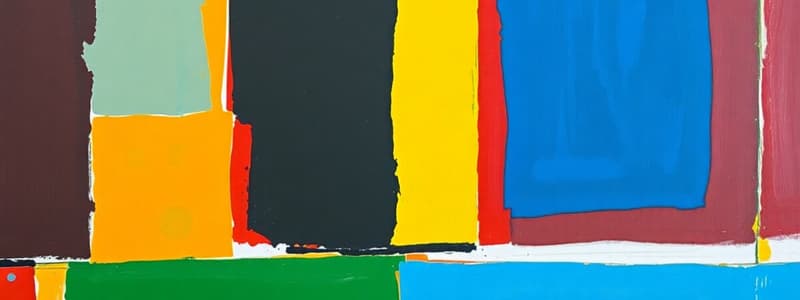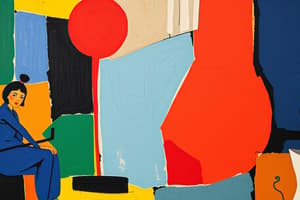Podcast
Questions and Answers
How did the Enlightenment influence the shift towards Neoclassicism?
How did the Enlightenment influence the shift towards Neoclassicism?
- By emphasizing reason, scientific inquiry, and questioning traditional norms, which aligned with Neoclassical ideals. (correct)
- By advocating for emotional expression and the rejection of classical forms.
- By promoting the revival of grand, ornate Baroque styles.
- By reinforcing the importance of aristocratic patronage in art.
In what way did Rococo art reflect the aristocratic society of its time?
In what way did Rococo art reflect the aristocratic society of its time?
- By emphasizing the importance of religious devotion and piety.
- By depicting the amusements and intimate scenes of French high society. (correct)
- By promoting revolutionary ideas and social change.
- By focusing on serious historical and moral themes.
What is a key characteristic that distinguishes Neoclassical art from Rococo art?
What is a key characteristic that distinguishes Neoclassical art from Rococo art?
- Adherence to classical forms, symmetry, and moral themes. (correct)
- Emphasis on ornate decoration and asymmetry.
- Focus on grand, dramatic scenes with intense emotion.
- Use of pastel colors and playful themes.
How did the changing views on reason and feeling influence artistic movements like Romanticism?
How did the changing views on reason and feeling influence artistic movements like Romanticism?
How did the societal view of aristocracy change, leading to shifts in art and societal values?
How did the societal view of aristocracy change, leading to shifts in art and societal values?
How does the theme of the 'Grand Tour of Italy' relate to the rise of Neoclassicism?
How does the theme of the 'Grand Tour of Italy' relate to the rise of Neoclassicism?
What role did philosophers like Voltaire play in influencing the shift from Rococo to Neoclassical art?
What role did philosophers like Voltaire play in influencing the shift from Rococo to Neoclassical art?
What underlying belief is reflected in Rousseau's idea that 'society corrupts the innate good in man'?
What underlying belief is reflected in Rousseau's idea that 'society corrupts the innate good in man'?
How did the fall of absolutism and the rise of common values influence the arts during the transition from Rococo to Neoclassicism?
How did the fall of absolutism and the rise of common values influence the arts during the transition from Rococo to Neoclassicism?
What role did the questioning and application of the scientific method play in the shift from Rococo to Neoclassicism?
What role did the questioning and application of the scientific method play in the shift from Rococo to Neoclassicism?
Flashcards
Rococo
Rococo
An artistic style characterized by intimacy, excessiveness, and French high society amusement.
Enlightenment
Enlightenment
A philosophical movement emphasizing reason and scientific inquiry, leading to questioning and the Industrial Revolution.
Feeling (versus Reason)
Feeling (versus Reason)
The study of human emotions and experiences versus reason.
Symbolism
Symbolism
Signup and view all the flashcards
First Impressionism Show
First Impressionism Show
Signup and view all the flashcards
Impressionism
Impressionism
Signup and view all the flashcards
Impressionism Style
Impressionism Style
Signup and view all the flashcards
En plein air painting
En plein air painting
Signup and view all the flashcards
Post-Impressionism
Post-Impressionism
Signup and view all the flashcards
Video Impressionism
Video Impressionism
Signup and view all the flashcards
Study Notes
- Rococo transitioned into Neoclassicism
Rococo
- Served as an intimate and excessive evolution of the Baroque style
- Commonly featured amusements of French high society
- The fall of Absolutism and powerful monarchs caused a return to common values
Enlightenment and Neoclassicism
- Emphasized questioning and the scientific method
- Led to the Industrial Revolution
- The Grand Tour of Italy became popular
Philosophers
- Advocated morality, portrayed in art to teach lessons to the public
- Championed art as heroic and virtuous
- Voltaire promoted anti-king, government, and noble privilege sentiments
- Advocated for freedom of religion and thought
- Jean-Jacques Rousseau believed in advancing humanity through science and rationality
- Rousseau emphasized the importance of feeling over reason, believing society corrupts the innate goodness in people
Jean-Honoré Fragonard's "The Swing"
- Embodies Rococo style with its rich, fancy aesthetic
- Depicts a love affair with an angel whispering, a guy hiding in bushes for love, and angels playing in the background
Joseph Wright of Derby's "A Philosopher Giving a Lecture at the Orrery"
- Represents the Enlightenment period
- Showcases scientific investigation aimed at improving humanity
- Contributed to the Industrial Revolution, features a living philosopher, and evokes awe among those watching
Vigée-Lebrun's "Self-Portrait"
- Features the artist herself
- Reflecting Rococo style with casual, carefree elements in bright colors, not pastels
- A self-assured gaze is present
Jacques-Louis David's "Oath of the Horatii"
- Moves away from Rococo with strong colors
- Adopts a Neoclassical style by depicting figures in togas and setting the scene with arches reminiscent of Rome
Thomas Jefferson's Monticello
- Employs Greco-Roman architectural elements, such as columns
- Reflecting Classical style, emulating Rome, to signify wisdom
Horatio Greenough's "George Washington"
- Presents a Neoclassical statue
- Featuring classical elements and contrasts
- Classical contrasts, symbolism with thirteen colonies and the Fasces
- Designed sizing to make him powerful looking
Romanticism, Realism, and Photography
- Features included past ideals, longing for the medieval past, pre-industrial Europe, irrationality, inner mind, insanity, and human psyche
- Depicted topics that transcend reason and nature
Features of Realism
- Centered on ordinary people
- Involving accurate, non-idealized depictions and visible brushstrokes
- Averse to artifice, it should not look like a painting
Jean-Auguste-Dominique Ingres' "La Grande Odalisque"
- Combines exotic and Romantic elements
- Painted a harem, exotic, and romantic with the teacher David and sharpness
Francisco Goya's "Los Desastres de la Guerra (The Disasters of War)"
- Etchings protest the French occupation of Spain and reveal the inhumane aspects of war
- Painted in white to show innocence
Francisco Goya's "The Third of May, 1808"
- Depicts the execution of Spanish citizens by French soldiers
- Evokes the feeling of innocent
Eugène Delacroix's "Liberty Leading the People"
- Captures a protest or revolution
- Documents a historical event, portraying people from all social classes coming together
- Characterizing an allegorical woman as Lady Liberty leading the people in Paris
J.M.W. Turner's "Slave Ship (Slavers Throwing overboard the Dead and Dying, Typhoon coming on)"
- Romantic to realism elements and loose brushstrokes
- Made to advocate for anti-slavery
Thomas Cole's "The Oxbow"
- Displays the U.S. with a contrast between beautiful, civilized land and untamed wilderness
- Artist in the land that is being painted to be real
Augustus Pugin and Charles Barry's Palace of Westminster (Houses of Parliament)
- Gothic style, texture, layout, classical architecture
Gustave Courbet's "The Stone Breakers"
- Realism and they are not looking at the audiance to show the audience can not relate
- Men are trappend in society
Honoré Daumier's "Rue Transnonain, April 15, 1834"
- Realism of family that has been murdered from a civil war
- White night shift shows innocence
Édouard Manet's "Olympia"
- Inspired but the artist did not like it
- Realism by ordinary people
- Hand is detailed and drawing us in but offensive
- Slave is in the room
Louis Daguerre's "Still Life in Studio"
- Daguerreotype that would take 20 mins
Eadweard Muybridge's "Horse Galloping"
- Showcases a horse mid-run
- The horse's legs are fully off the ground at one point
Impressionism
- A primary gallery debuted in 1874, facing criticism for its departure from academic norms
- Aims at capturing a fleeting moment
- Examined light and color outdoors
Post-Impressionism
- The Impressionist movement was followed by studying other elements
- The study of structure and solid forms, also perspective
Symbolism
- Inspired by mystical dreams and inner experiences
- Focused on deeply felt emotions rather than superficial observations
Art Nouveau
- Included combining materials and unified experience
- Featured complexity of design and undulating forms
Claude Monet's "The Saint-Lazare Station"
- Depicts everyday life with bumpy strokes, colors like smoke
- Does not feel planned
Mary Cassatt's "The Coiffure"
- Embodies Impressionism with bright colors and capturing a fleeting moment
- Reflected a fascination with Japanese art
Vincent van Gogh's "The Starry Night"
- Features cypress trees symbolizing death
- Demonstrates Japanese woodcut inspiration and expresses a distinct style
Paul Gauguin's "Where Do We Come From? What Are We? Where Are We Going?"
- Post-Impressionist work painted in Tahiti, depicting what he saw
- Contains cultural views, representing the beginning, the middle, and the end
Paul Cézanne's "Mont Sainte-Victoire"
- Post-Impressionist work emphasizing solid forms rather than random strokes
- Depicts a real mountain from his backyard
Auguste Rodin's "The Burghers of Calais"
- Impressionistic bronze sculpture with a captured texture of the skin and made fast
- The war of the 100 years
Edvard Munch's "The Scream"
- Displays the subject having a panic attract with friends moving on
- To capture the feeling of the day
Gustav Klimt's "The Kiss"
- Conveys intense love
- Features a couple in a garden with real gold
Antoni Gaudí's Sagrada Família
- Gothic inspiration and undulation lights and colors, dying before seeing it completed
- Represents of growth, reminiscent of trees and branches
Studying That Suits You
Use AI to generate personalized quizzes and flashcards to suit your learning preferences.




